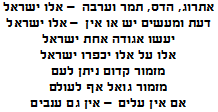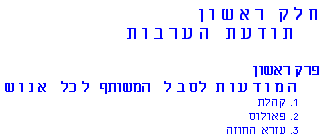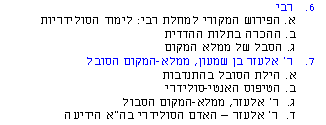|
ZW E I T E R T
E I L
DIE LEHRE VON DER SOLIDARITAET
[bundle
13]
Erstes Kapitel:
Die goettliche Solidaritaet
1. Theologie als
Spiegel der Anthropologie
2. JHWH, der solidarische Gott Mose's
3. Die Solidaritaet des Heiligen-gelobt-sei-er
[bundle
14]
Zweites Kapitel:
Haftung-Solidaritaet-Verantwortung
1. Der Unterschied zwischen goettlicher
und menschlicher Solidaritaet
2. "Kein Gefangener loest sich selbst aus
dem Gefaengnis"
3. Das Lebensgesetz
[bundle
15]
Drittes Kapitel: Zwei Beispiele von Solidaritaet in der
Bibel
1. Die Konkubine des Leviten:
Solidaritaet der Gemeinschaft mit einem Einzelnen
2. Die Konkubine des Koenigs:
Solidaritaet eines Einzelnen mit der Gemeinschaft
Zusammenfassung
Viertes Kapitel:
Die ausdrueckliche rabbinische Lehre von der Solidaritaet
[bundle
16]
1. Solidaritaet des Einzelnen mit der Gemeinschaft
a)
Die Warnung im Gesetz
b) Die Solidaritaet & die Verantwortlichkeit
des Einzelnen
c) Die Identifikation mit der Gemeinschaft
zu jeder Zeit
[bundle
17]
2. Solidaritaet des Menschen mit seinem Andern
a)
Die Lektion der Geschichte
b) Die Identifikation als Motivation rabbinischer
Ethik
c) Die Bedeutung des
'Halte lieb deinen Andern, dir
gleich'
[bundle
18]
d) Die Anwendung der "Regel"
in der Weisung selber
e) Die Anwendung der
"Regel" bei den Rabbinen
f) Die Solidaritaet angesichts des Todes
[bundle
19]
3. Die Solidaritaet der Gemeinschaft mit dem Leidenden
Andern
Zusammenfassung
|
S E C O N D
P A R T
The T E A C H I N G of S
O L I D A R I T Y
[bundle
13]
First Chapter
Divine
Solidarity
1. Theology as
a reflection of anthropology
2. JHWH, the solidary God of Moses
3. The solidarity of the Holy-one-blessed-be-he
[bundle
14]
Second Chapter
Guarantorship-Solidarity-Responsibility
1. The difference
between divine and human solidarity
2. "No prisoner unties himself from prison"
3. The Law of Life
[bundle 15]
Third Chapter
Two Examples of Solidarity in the Bible
1. A community's solidarity
with the individual
(the concubine of the Levite)
2. An individual's solidarity with the community
(Esther, the concubine of the king)
Summary
Fourth Chapter
The S a g e s ' C o n c e p t u a l i z e d
T e a c h i n g of S o l i d a r i t y
[bundle
16]
1. The solidarity
of the individual with the community
a) The warning in the Law
b) The solidarity and responsibility of the individual
c)The identification with the community at all times
[bundle
17]
2. The solidarity of everybody with his fellow
a) The lesson of
history
b) G: Identification as motivation in rabbinical ethics
b) H: "A big rule in the Torah"
: The Sages' estimate
c) G: The meaning of
"Be-loving to your fellow (as one) like
you" (Levit. 19,18)
c) H: "your fellow like you",
the meaning of the rule
[bundle
18]
d) G: The application of the "Rule"
in the Torah itself
e) G: The application
of the "Rule" by Israel's
Sages
f) Solidarity in the face of death
[bundle
19]
3. The solidarity of the community with the individual
Summary
|
|



















